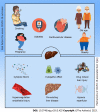COVID-19 and hepatic injury: cellular and molecular mechanisms in diverse liver cells
- PMID: 36688024
- PMCID: PMC9850933
- DOI: 10.3748/wjg.v29.i3.425
COVID-19 and hepatic injury: cellular and molecular mechanisms in diverse liver cells
Abstract
The coronavirus disease 2019 (COVID-19) represents a global health and economic challenge. Hepatic injuries have been approved to be associated with severe acute respiratory syndrome coronavirus (SARS-CoV-2) infection. The viral tropism pattern of SARS-CoV-2 can induce hepatic injuries either by itself or by worsening the conditions of patients with hepatic diseases. Besides, other factors have been reported to play a crucial role in the pathological forms of hepatic injuries induced by SARS-CoV-2, including cytokine storm, hypoxia, endothelial cells, and even some treatments for COVID-19. On the other hand, several groups of people could be at risk of hepatic COVID-19 complications, such as pregnant women and neonates. The present review outlines and discusses the interplay between SARS-CoV-2 infection and hepatic injury, hepatic illness comorbidity, and risk factors. Besides, it is focused on the vaccination process and the role of developed vaccines in preventing hepatic injuries due to SARS-CoV-2 infection.
Keywords: COVID-19; COVID-19 comorbidity; Hepatic injury; Vaccination; Viral tropism.
©The Author(s) 2023. Published by Baishideng Publishing Group Inc. All rights reserved.
Conflict of interest statement
Conflict-of-interest statement: All the authors report no relevant conflicts of interest for this article.
Figures
References
-
- Guan Y, Zheng BJ, He YQ, Liu XL, Zhuang ZX, Cheung CL, Luo SW, Li PH, Zhang LJ, Guan YJ, Butt KM, Wong KL, Chan KW, Lim W, Shortridge KF, Yuen KY, Peiris JS, Poon LL. Isolation and characterization of viruses related to the SARS coronavirus from animals in southern China. Science. 2003;302:276–278. - PubMed
Publication types
MeSH terms
LinkOut - more resources
Full Text Sources
Medical
Miscellaneous


